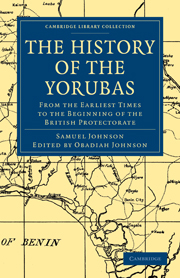2 - THE YORUBA LANGUAGE
Published online by Cambridge University Press: 05 July 2011
Summary
The Yoruba language has been classed among the unwritten African languages. The earliest attempt to reduce this language into writing was in the early forties of the last century, when the Church Missionary Society, with the immortal Rev. Henry Venn as Secretary, organized a mission to the Yoruba country under the leadership of one of their agents, the Rev. Henry Townsend, an English Clergyman then at work at Sierra Leone, and the Rev. Samuel Ajayi Crowther, the first African Clergyman of the C.M.S., also at work in the same place.
After several fruitless efforts had been made either to invent new characters, or adapt the Arabic, which was already known to Moslem Yorubas, the Roman character was naturally adopted, not only because it is the one best acquainted with, but also because it would obviate the difficulties that must necessarily arise if missionaries were first to learn strange characters before they could undertake scholastic and evangelistic work. With this as basis, special adaptation had to be made for pronouncing some words not to be found in the English or any other European language.
The system, or rather want of system, existing among various missionary bodies in Africa and elsewhere emphasized the need of a fixed system of orthography.
- Type
- Chapter
- Information
- The History of the YorubasFrom the Earliest Times to the Beginning of the British Protectorate, pp. xxiii - xxxiiPublisher: Cambridge University PressPrint publication year: 2010First published in: 1921



